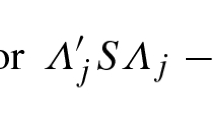Abstract
This paper is concerned with the study of similarities and differences in factor structures between different groups. A common situation occurs when a battery of tests has been administered to samples of examinees from several populations.
A very general model is presented, in which any parameter in the factor analysis models (factor loadings, factor variances, factor covariances, and unique variances) for the different groups may be assigned an arbitrary value or constrained to be equal to some other parameter. Given such a specification, the model is estimated by the maximum likelihood method yielding a large samplex 2 of goodness of fit. By computing several solutions under different specifications one can test various hypotheses.
The method is capable of dealing with any degree of invariance, from the one extreme, where nothing is invariant, to the other extreme, where everything is invariant. Neither the number of tests nor the number of common factors need to be the same for all groups, but to be at all interesting, it is assumed that there is a common core of tests in each battery that is the same or at least content-wise comparable.
Similar content being viewed by others
References
Box, G. E. P. A general distribution theory for a class of likelihood criteria.Biometrika, 1949,36, 317–346.
Fletcher, R. & Powell, M. J. D. A rapidly convergent descent method for minimization.The Computer Journal, 1963,6, 163–168.
Gruvaeus, G. T. & Jöreskog, K. G. A computer program for minimizing a function of several variables. Research Bulletin 70-14. Princeton, N. J.: Educational Testing Service, 1970.
Holzinger, K. J. & Swineford, F. A study in factor analysis: The stability of a bi-factor solution.Supplementary Educational Monograph No.48. Chicago: University of Chicago, 1939.
Jöreskog, K. G. Some contributions to maximum likelihood factor analysis.Psychometrika, 1967,32, 443–482.
Jöreskog, K. G. A general approach to confirmatory maximum likelihood factor analysis.Psychometrika, 1969,34, 183–220.
Lawley, D. N. A note on Karl Pearson's selection formulae.Proceedings of the Royal Society of Edinburgh, Section A, 1943–44,62, 28–30.
Lawley, D. N. & Maxwell, A. E.Factor analysis as a statistical method. London: Butterworths, 1963.
McGaw, B. & Jöreskog, K. G. Factorial invariance of ability measures in groups differing in intelligence and socioeconomic status.British Journal of Mathematical and Statistical Psychology, 1971,24,in press.
Meredith, W. Rotation to achieve factorial invariance.Psychometrika, 1964,19, 187–206. (a)
Meredith, W. Notes on factorial invariance.Psychometrika, 1964,29, 177–185. (b)
van Thillo, M. & Jöreskog, K. G. A general computer program for simultaneous factor analysis in several populations. Research Bulletin 70-62. Princeton, N. J.: Educational Testing Service, 1970.
Author information
Authors and Affiliations
Additional information
This research was supported by grant NSF-GB-12959 from National Science Foundation. My thanks are due to Michael Browne for his comments on an earlier draft of this paper and to Marielle van Thillo who checked the mathematical derivations and wrote and debugged the computer program SIFASP.
Now at Statistics Department, University of Uppsala, Sweden.
Rights and permissions
About this article
Cite this article
Jöreskog, K.G. Simultaneous factor analysis in several populations. Psychometrika 36, 409–426 (1971). https://doi.org/10.1007/BF02291366
Received:
Revised:
Issue Date:
DOI: https://doi.org/10.1007/BF02291366




